
30 May Tour de Flathead
Still have that old canary-yellow Schwinn Varsity bicycle hanging from the rafters in your parents’ barn? You know the one: the steel-framed groaner whose tires haven’t been inflated since the Carter administration. Pull it down, grease its chain, tune its brakes, and see if those time-cracked tires will hold air. Maybe even wrap the rusty handlebars with fresh cloth tape.

This rider has just negotiated the final hairpin turn and is on the steepest part of the big descent into Nirada after Day 1 lunch. Sullivan Hill, aka Suicide Hill, has been known to blow tires, eat brake pads, snap seat posts, and vaporize chainring bolts.
You can further give it new life this September by joining riders of all sorts of similarly vintage bicycles in Montana’s Flathead Valley to celebrate the golden age of two-wheeled touring, classic continental food, and fellowship.
These are the participants in Cino Heroica, a two-day, 110-mile bicycle ride along graveled backroads from the small northwest Montana town of Kila to the equally small town of Hot Springs, and back again. This year’s running — September 14 and 15 — marks the 16th ride of the Cino (pronounced “chee-no,” like the pants), but it’s less of a race than a celebration of stylish bikes, good French wine, and an outlook on life that values the experience just as much as the destination.

This classic fixed-gear bicycle sports a vintage cork-stoppered water bottle.
That outlook can be summed up in the event’s name. “Heroica” is an homage to one of the world’s original bike tours, L’Eroica, that wends through the Italian countryside, with riders stopping frequently to eat memorable food, sip rustic wine, and recall the heyday of Europe’s touring bike culture, in which style and companionship counted for more than performance.
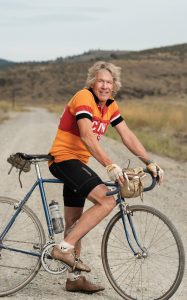
Reed Gregerson, known as the godfather of Cino, is the man who started it all.
In the Flathead rendition, “Heroica” also means fully embracing the spirit of the race, wearing vintage Italian bike jerseys, stopping frequently to enjoy the ride or to help a fellow rider, and acknowledging and embodying the idea that pedaling 110 miles over bad roads on old, stiff, creaky bikes is improved when you savor a glass of wine at lunch.
The “Cino” half of the event’s name is also an homage — to the legendary Italian bike racer Cino Cinelli, who founded the eponymous bicycle company and whose panache defined a certain era of bike and rider from the decades before televised races, million- dollar sponsorships, and performance-enhancing drugs.
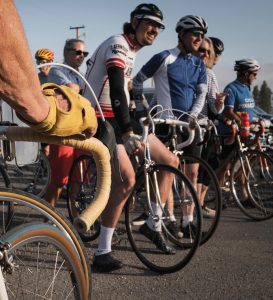
A collection of vintage bicycles and their riders display their Heroica stamps on their race numbers.
The Flathead event borrows from the early European grand bike tours and the French word randonneur, loosely translated to “ramble” in English. The name and the idea behind it are “rooted in the spirit of self-supported long-distance riding at one’s own pace,” says David Cummings, who, after years of organizing the event, is stepping down this year into an emeritus role that he describes as “spiritual director.”
Don’t ride the Cino to set speed records. Ride the Cino to enjoy sweeping views of northwest Montana’s high sage and timbered basins, and to spend two afternoons leisurely pedaling with fellow Francophile bike riders who enjoy the finer things in life, including itchy old wool racing jerseys.
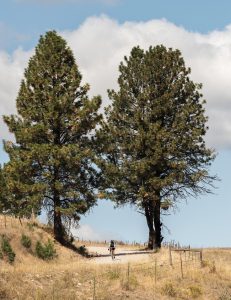
Though everyone starts together, cyclists spread out as the day progresses over the gravel roads and low passes of the Flathead.
TUSCAN ORIGIN STORY
“We call the founders of Cino Heroica the ‘godfathers.’ They include Reed Gregerson, who went to Italy to experience L’Eroica in the early 2000s and came back to the Flathead thinking it would be fun to try to replicate it here,” says Cummings, who inherited organizational chores from the godfathers. Cummings is a teacher at Kalispell Montessori Elementary School, and the Cino is a fundraiser for the school. “The first year, it was really just the godfathers and a couple of friends. The second year, it doubled, because each of them told someone else; then it doubled again for the same reason. It morphed into an annual thing that, at its height prior to COVID, had over 150 riders.”
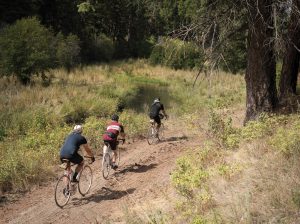
Riders approach the hidden waterfall that graces the Day 1 lunch spot.
The event has been capped at 165 riders, though it’s rarely swelled to that limit. Instead, it’s more frequently ranged from 50 to 100 bikers, who travel about 60 miles the first day, overnight at Hot Springs — normally camping on the lawn of Alameda’s Hot Springs Resort, though a limited number of rooms are reserved months in advance — and enjoy a candle-lit catered dinner, auction, social time, and soak, often a required remedy for bruised posteriors. The second day sends riders back to Kila over an intimidating grade. By the time they return to their starting point, most participants are already formalizing plans to return the following year.
This year, the Cino is moving to September, pushed back from its traditional summer weekend to take advantage of cooler weather and lower off-season prices for everything from airfare to hotels in Glacier Country. But what remains is what Cummings calls the “ride through time in a corner of Montana that the world forgot.”
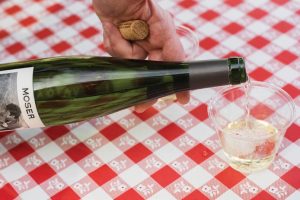
The original energy drink: wine.
Nearly every rider brings a bike that time, indeed, forgot. One of the defining elements of Cino Heroica is the single-speed, two-speed, and vintage multi-speed bikes that are lovingly restored and brought out for special events like the Cino. Participants come mainly from the West Coast, though every year, a rider from the East Coast or even Europe shows up.
A CELEBRATION OF VINTAGE BICYCLING
“The real bike nerds pull out all the stops and bring their coolest bikes,” says Cummings. You’ll see Cinellis, Masis, and Bottechias (all post-war Italian bikes that readers or the author may or may not be familiar with). You’ll ride alongside Schwinn Varsities and Suburbans. You’ll see tubular tires, steel frames, white socks, and vintage leather bike helmets. There’s equal parts cosplay and genuine affection for the gear of a simpler time.

Vintage leather padded gloves offer some comfort from shellacked cloth handlebar tape.
You’ll see “iron men who do Cino with a fixed gear and a prayer,” standing on their pedals and straining as they climb the graveled grades, notes Cummings.
And about that gravel… “A lot of Cino rides are from the 1960s and ’70s, dating from the big bike boom of the 10-speeds,” says Cummings. “Those bikes could handle larger-sized tires — 32 and 38 millimeter — and they are well built to handle the roads we go over. Our inspiration is the European grand tours in the days before paved roads. You have to remember that they were riding over graveled mountain passes in the early versions of the Tour de France.”

Don Hickerson completed the Cino at 80 years of age.
What about riders who bring modern mountain bikes and carbon-fiber rides to Cino Heroica? “The tradition and spirit of the ride revolves around vintage bikes,” reads Cino Heroica’s website. “That said, we welcome all non-electric bikes and their riders.”
But bring a modern bike at your peril. You can expect to be teased, chastised, and reminded that the bike — and, by extension, the biker — isn’t nearly as heroic as those riders who suffer the washboards, fist-sized cobble, and flat tires of the route on a bike that was built when Lance Armstrong was a toddler.
“I wince a little when people call it a race,” says Cummings. “We do give an award for performance; the first man and woman who get to Hot Springs get their dinner paid for. But this isn’t a race. It’s a ride. We’re there to enjoy the scenery, enjoy the camaraderie, and enjoy the bikes.”
Cummings says the idea behind stressing vintage gear is to strip away all the advantages and distractions of technology. “If you pace yourself, and you stop and smell the flowers, and you enjoy the rest stops, you’re going to end up fine.”
And don’t expect energy drinks or protein gels at the occasional (and changeable) rest stops. Instead, you’re more likely to be handed a hunk of good bread, cheese, and a glass of wine.
EMBRACING FAILURE
Cummings says veteran riders expect to budget time to fix flats and repair bikes. “If you can think of a bike part, we’ve had it fall off,” he laughs. “We’ve had saddles fall off, brake pads just disappear, and chains disintegrate. One year, we had a rider who towed another rider after he broke a crank, so he had only one pedal.”
“We’re almost entirely on county roads, and you don’t know from one year to the next what shape it’s going to be in, depending on when the county gravels it and what they decide to gravel it with. There are baby heads in the roads, washouts with ruts, and one year I swear it was paved with river rocks.”
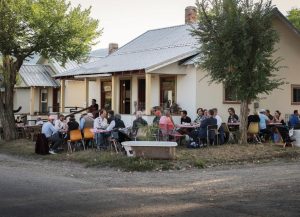
A sit-down dinner in Hot Springs is a welcome end to a long day’s ride.
Cummings says the most common malady is flat tires. “If you don’t have your pressures up high enough and you hit a rock or a rut flat-out, then you’re going to get a pinch flat,” he says. “It just goes with those tires and those tubes. For years, the record number of flats was seven, but then a year or two ago, we had a husband and wife show up on a vintage tandem bike with 25-millimeter sew-up tires that you have to glue on — old school — and I think they had seven flats in the first half of the first day. They went through every tire they had and had to catch a ride in. Now, that’s heroic.”
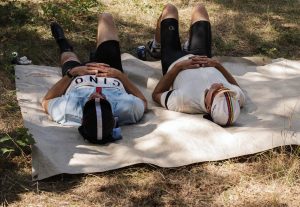
A post-lunch nap offers a rejuvenating pause before the final half of Day 1.
So is the Cino Heroica’s website, which provides possibly exaggerated descriptions of the event and its ethos, including altered quotes like that of John F. Kennedy as he called Americans to support the exploration of space: “We choose to ride the Cino on bikes older than a decade, and do the other things. Not because they are easy, but because they are hard.”
That pretty much sums up the vibe of this classic continental bike tour, heroically translocated to the picturesque (and rough) backroads of northwest Montana.
Andrew McKean writes about hunting, conservation, and wildlife management from his home in Glasgow, Montana. The former editor in chief of Outdoor Life magazine and the current hunting editor, McKean is the author of How To Hunt Everything. He also contributes to a number of national publications.
Nick VanHorn left the hustle and bustle of Fort Collins, Colorado after college in search of wide-open spaces. Since landing in Montana, VanHorn has worn a variety of hats, from ski patroller to bike mechanic to broadcast television professional. Whatever the task, VanHorn can be found with a camera in hand to document the journey.



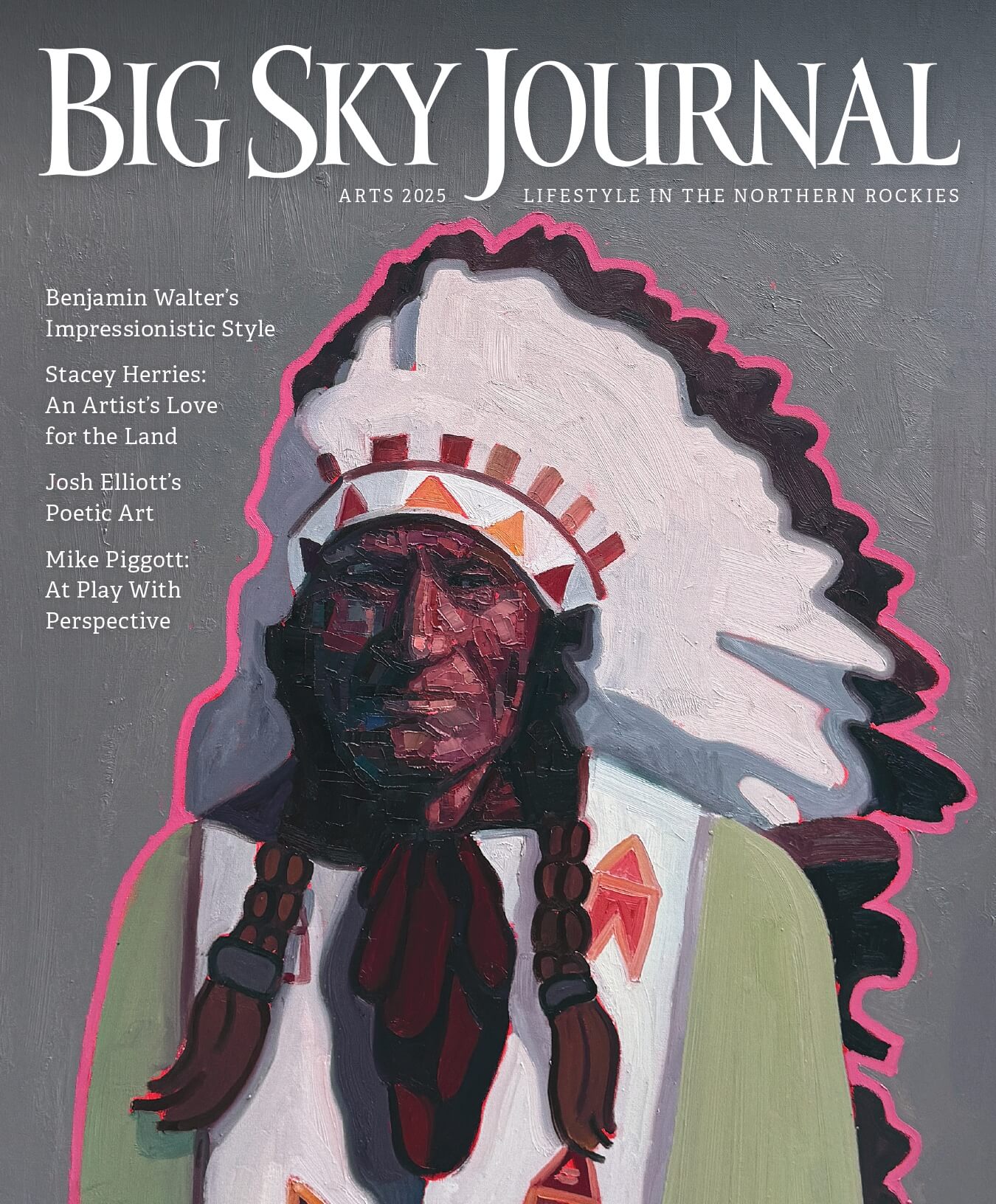
Dave Diamond
Posted at 02:13h, 31 MayOne thing the article forgot to mention is that this is likely the friendliest ride you will ever participate in. My experience is that you may start out with a bunch of strangers but by the end of the ride you have new lifelong friends.
Mike Dalton
Posted at 02:32h, 10 SeptemberGreat article! Can you give me a contact person on how I can sign up for 2025 tour? Thanks for all that you do.